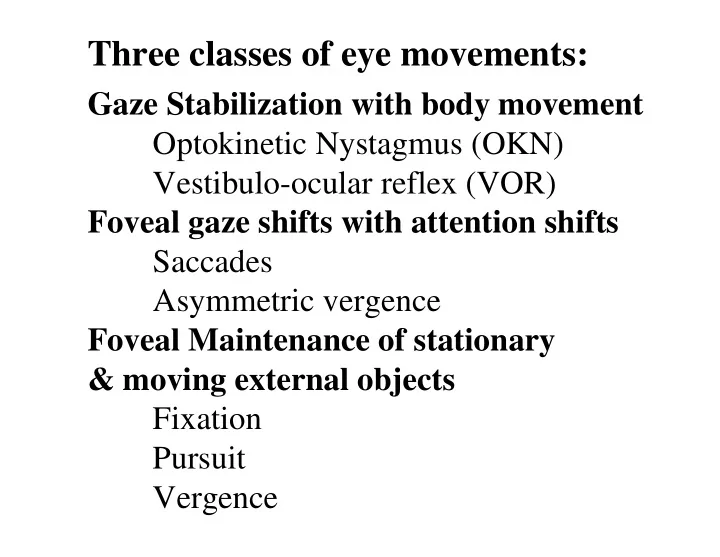

Three classes of eye movements: Gaze Stabilization with body movement Optokinetic Nystagmus (OKN) Vestibulo-ocular reflex (VOR) Foveal gaze shifts with attention shifts Saccades Asymmetric vergence Foveal Maintenance of stationary & moving external objects Fixation Pursuit Vergence
VOR holds gaze steady
Canal planes
Jerk Nystagmus
Asymmetric OKN
Head vs. Eye Pursuit
Derivation of “Saccade”
Visual Search Saccades
Micro-Fixation Saccades
Reading Gaze Shifts
Three degrees of freedom describe eye rotations about 3 axes
Three classes of vergence
Iso Vergence Circles & Iso Version Lines
Hierarchy of Oculomotor Control Final Common Pathway- executes movement Pre-motor nuclei- coordinates movement Supra-nuclear centers- plans movement
Final Common Pathway Motor nuclei of cranial nerves III, IV and VI provide innervation that produces force applied by individual muscles. Movements of all speeds and types (version and vergence) are controlled here.
Pre-motor nuclei: choreograph complex movements These brainstem centers and cerebellum coordinate combined actions of several muscles. They orchestrate direction, amplitude, velocity and duration of eye rotation. This level computes the innervation necessary to achieve a desired eye rotation
Supra-nuclear pathways: Plan objectives Plan the desired direction and distance of gaze with eyes and head rotations. Transform sensory afferent into motor efferent commands. Includes cortical areas and the superior colliculus.
Hierarchy of Oculomotor Control Supra-nuclear Neurons Cortical Gaze control Cortical Gaze control Motor Voluntary control, (FEF, MT, V1, V2) (FEF, MT, V1, V2) spatial frame of reference Visual Pre-motor Neurons PreMotor Gaze Centers PreMotor Gaze Centers Reflex movement, (VI, VIII, riMLF, PPRF, pulse generation, (VI, VIII, riMLF, PPRF, i.n.Cajal, S.C.) integration i.n.Cajal, S.C.) Adaptive Adaptive control Motor neurons control Oculomotor Nuclei Oculomotor Nuclei (Cerebellum) Final common path, (Cerebellum) ( III, IV, VI) ( III, IV, VI) reciprocal innervation Muscles Oculomotor plant
Closed loop camera illustrations and Visigraph demonstration
Iso Vergence Circle A Points A and B have the same B Vergence angle. So do Points C and D. C Points A and C have the same D Version angle. So do Points B and D. This shows the Iso-Vergence Circle in the visual plane. Iso version lines or directions.
Recommend
More recommend